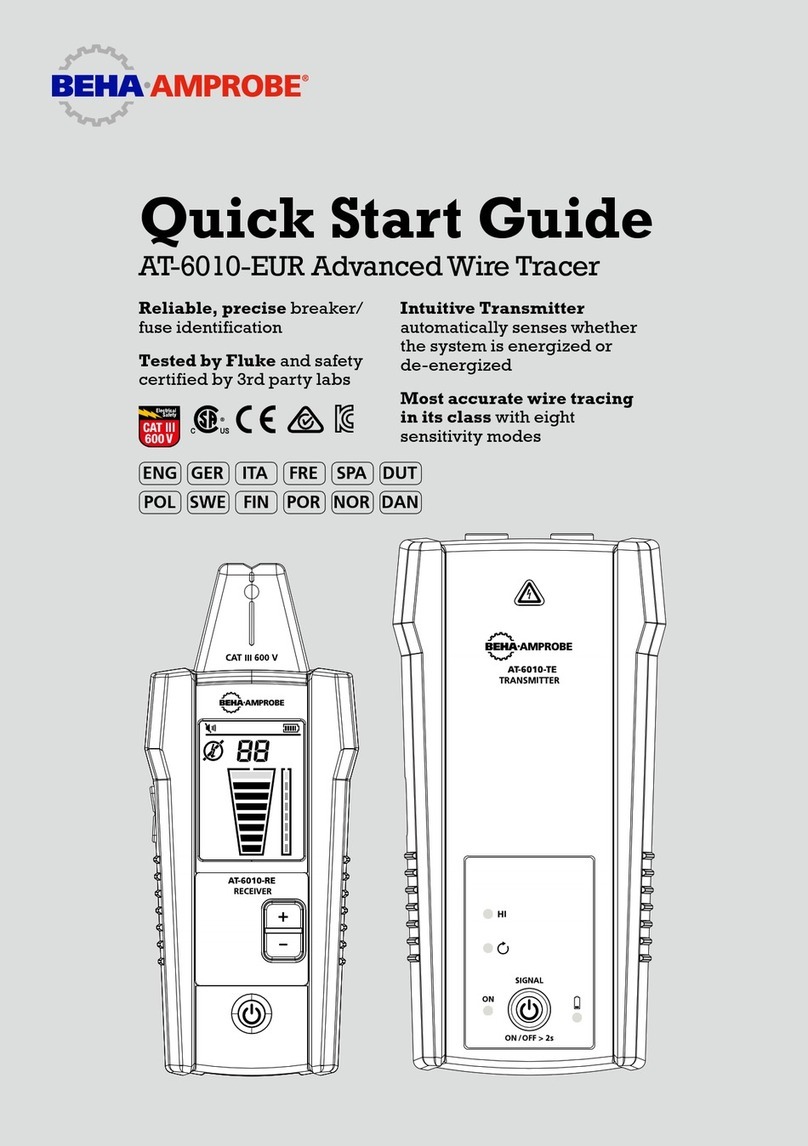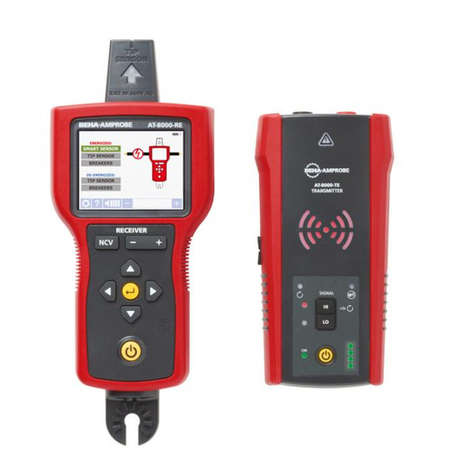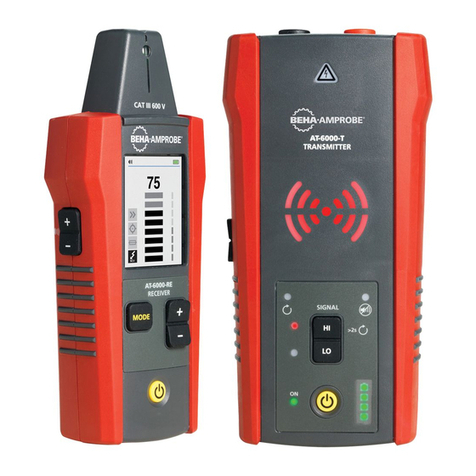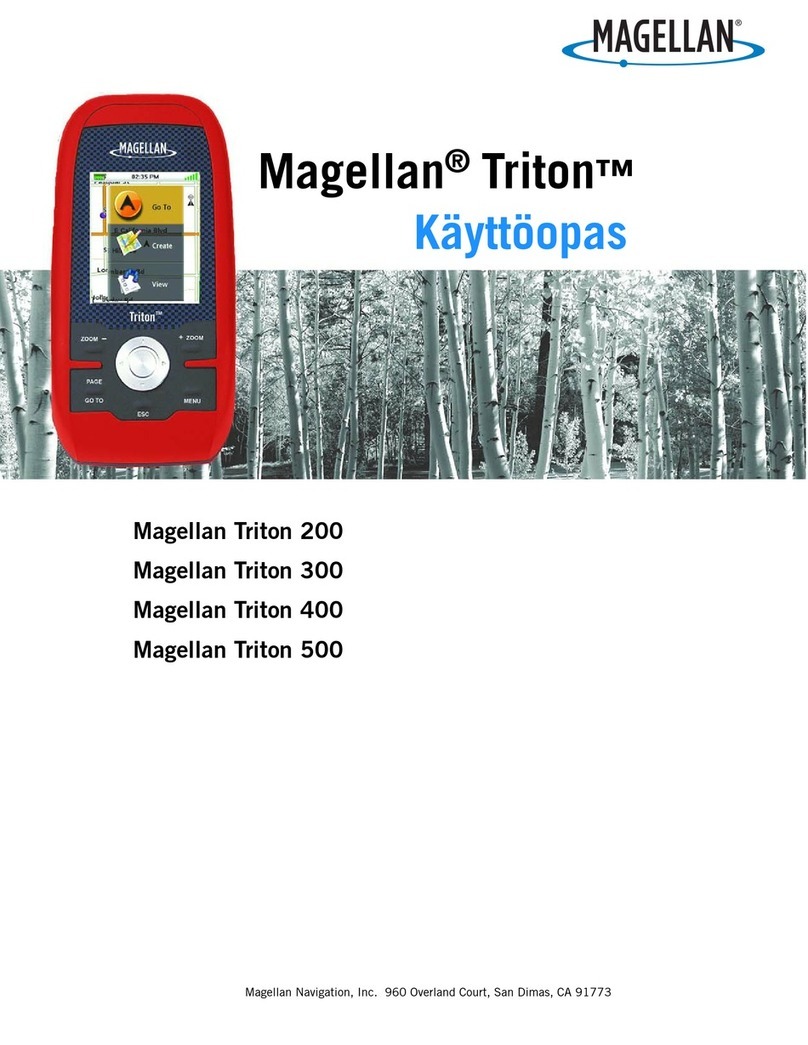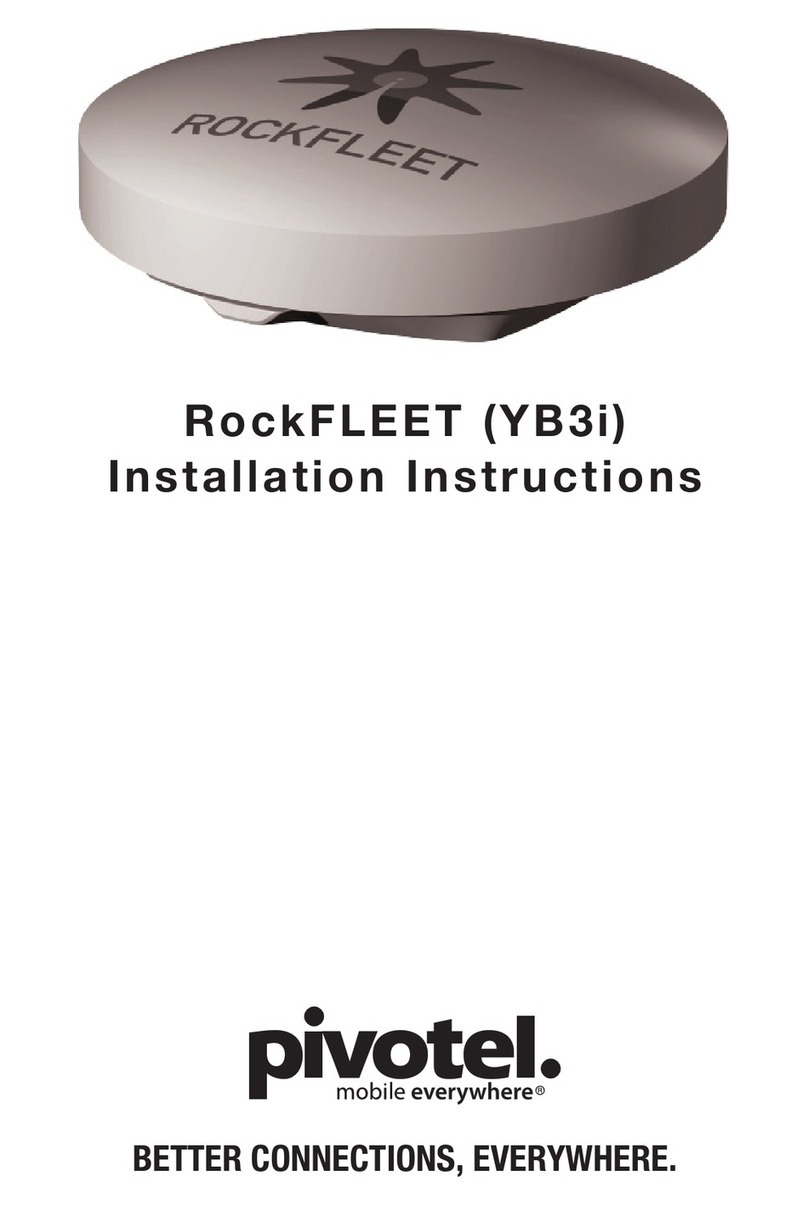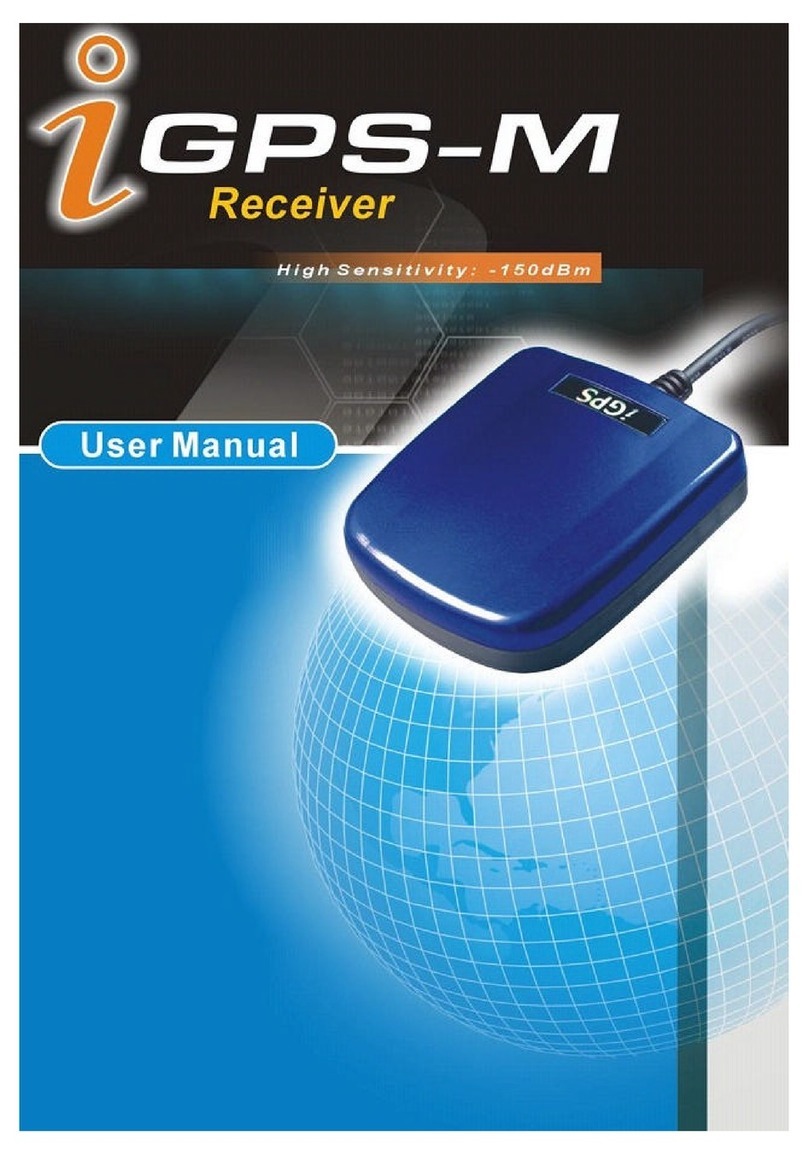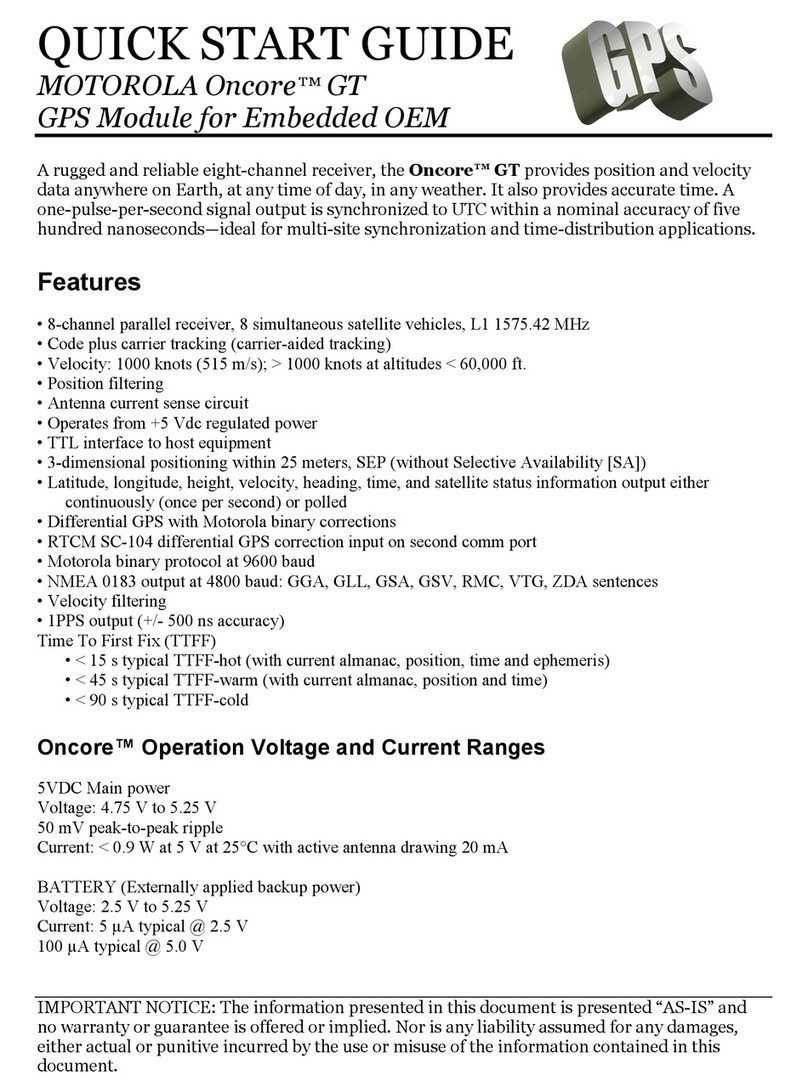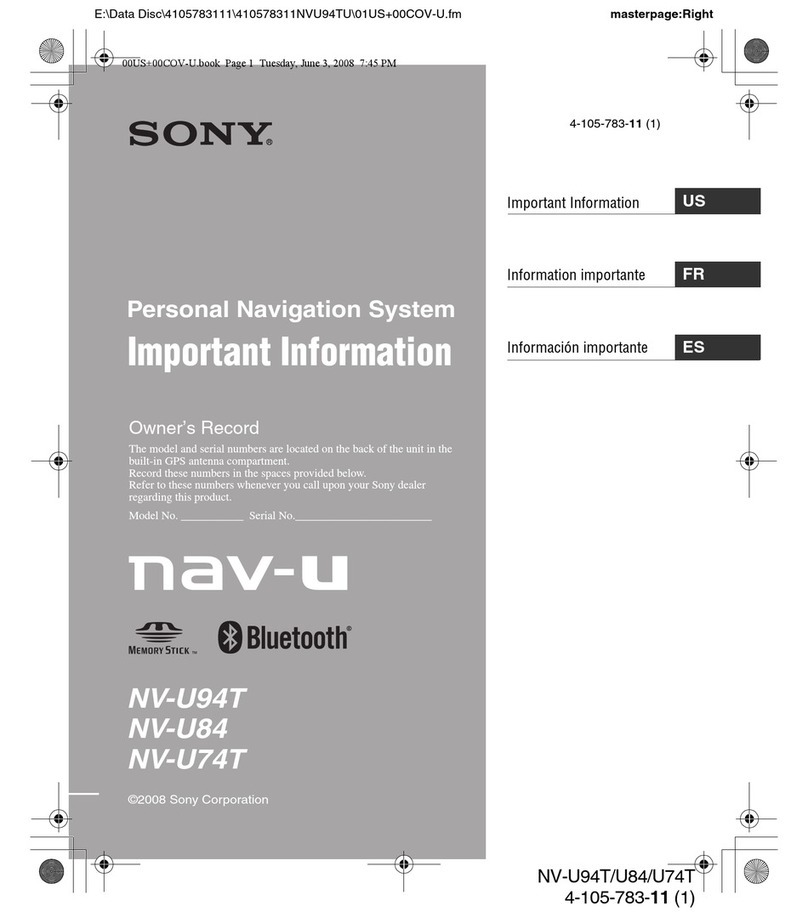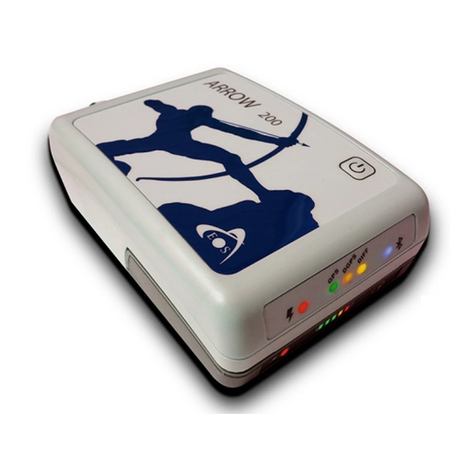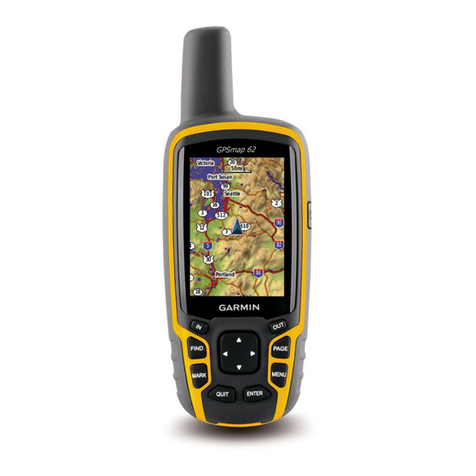Beha-Amprobe AT-8000-EUR Series User manual

AT-8000-EUR
Advanced Wire Tracers
AT-8020-EUR
AT-8030-EUR
User Manual
AT-8000-TE
AT-8000-RE
CAT IV 600 V AC
TIP
SENSOR
NCV
RECEIVER


English
AT-8000-EUR
Advanced Wire Tracer
AT-8020-EUR
AT-8030-EUR
User Manual
3/2020, 6012356 B
©2020 Beha-amprobe.
All rights reserved.

Limited Warranty and Limitation of Liability
Your Beha-Amprobe product will be free from defects in material and workmanship for
two years from the date of purchase unless local laws require otherwise. This warranty does
not cover fuses, disposable batteries or damage from accident, neglect, misuse, alteration,
contamination, or abnormal conditions of operation or handling. Resellers are not authorized
to extend any other warranty on the behalf of Beha-Amprobe. To obtain service during the
warranty period, return the product with proof of purchase to an authorized Beha-Amprobe
Service Center or to an Beha-Amprobe dealer or distributor. See Repair Section for details.
THIS WARRANTY IS YOUR ONLY REMEDY. ALL OTHER WARRANTIES - WHETHER EXPRESS,
IMPLIED OR STATUTORY - INCLUDING IMPLIED WARRANTIES OF FITNESS FOR A PARTICULAR
PURPOSE OR MERCHANTABILITY, ARE HEREBY DISCLAIMED. MANUFACTURER SHALL NOT BE
LIABLE FOR ANY SPECIAL, INDIRECT, INCIDENTAL OR CONSEQUENTIAL DAMAGES OR LOSSES,
ARISING FROM ANY CAUSE OR THEORY. Since some states or countries do not allow the
exclusion or limitation of an implied warranty or of incidental or consequential damages, this
limitation of liability may not apply to you.
Repair
All Beha-Amprobe tools returned for warranty or non-warranty repair or for calibration
should be accompanied by the following: your name, company’s name, address, telephone
number, and proof of purchase. Additionally, please include a brief description of the
problem or the service requested and include the test leads with the product. Non-warranty
repair or replacement charges should be remitted in the form of a check, a money order,
credit card with expiration date, or a purchase order made payable to Beha-Amprobe.
In-warranty Repairs and Replacement – All Countries
Please read the warranty statement and check your battery before requesting repair.
During the warranty period, any defective test tool can be returned to your Beha-Amprobe
distributor for an exchange for the same or like product. Please check the “Where to Buy”
section on beha-amprobe.com for a list of distributors near you. Additionally, in the United
States and Canada, in-warranty repair and replacement units can also be sent to an
Beha-
Amprobe Service Center (see address below).
Non-warranty Repairs and Replacement – Europe
European non-warranty units can be replaced by your Beha-Amprobe distributor for a nominal
charge. Please check the “Where to Buy” section on beha-amprobe.com for a list of distributors
near you.
Beha-Amprobe
Division and reg. trademark of Fluke Corp. (USA)
Germany*
In den Engematten 14
79286 Glottertal
Germany
Phone: +49 (0) 7684 8009 - 0
beha-amprobe.de
United Kingdom
52 Hurricane Way
Norwich, Norfolk
NR6 6JB United Kingdom
Phone: +44 (0) 1603 25 6662
beha-amprobe.com
The Netherlands - Headquarters**
Science Park Eindhoven 5110
5692 EC Son
The Netherlands
Phone: +31 (0) 40 267 51 00
beha-amprobe.com
*(Correspondence only – no repair or replacement available from this address. European
customers please contact your distributor.)
**single contact address in EEA Fluke Europe BV

1
AT-8000-EUR Advanced Wire Tracer
CONTENTS
1. PRECAUTIONS AND SAFETY MEASURES ............................................................. 2
2. KIT COMPONENTS................................................................................................. 5
2.1 AT-8000-RE Receiver ......................................................................................................6
2.2 AT-8000-TE Transmitter .................................................................................................8
2.3 CT-400-EUR Signal Clamp ..............................................................................................11
3. MAIN APPLICATIONS............................................................................................. 12
3.1 Tracing Energized Wires.................................................................................................13
• 3.1 a Using the Receiver in Energized SMART SENSORTM mode............................14
• 3.1 b Using Receiver in Energized Tip Sensor mode...............................................15
3.2 Tracing De-Energized Wires...........................................................................................16
• Using Receiver in De-Energized Tip Sensor mode
3.3 Identifying Breakers and Fuses......................................................................................17
• Using Receiver in Energized & De-Energized Breaker mode
3.4 Non-Contact Voltage Mode (NCV) ...............................................................................20
4. SPECIAL APPLICATIONS ........................................................................................ 21
4.1 RCD-Protected Circuit Wire Tracing..............................................................................21
4.2 Finding Breaks/Opens ...................................................................................................22
4.3 Finding Shorts ...............................................................................................................22
4.4 Tracing Wires in Metal Conduit ...................................................................................23
4.5 Tracing Non-Metallic Pipes and Conduits ....................................................................23
4.6 Tracing Shielded Wires ..................................................................................................24
4.7 Tracing Underground Wires..........................................................................................25
4.8 Tracing Low Voltage Wires and Data Cables ...............................................................25
4.9 Sorting Bundled Wires ..................................................................................................26
4.10 Mapping a Circuit using Test Leads Connection.........................................................27
4.11 Tracing Breakers/Fuses on Systems with Light Dimmers ............................................27
4.12 Signal Clamp - Closed Loop Circuits ............................................................................28
4.13 Signal Clamp - Mapping Circuits..................................................................................30
5. MAINTENANCE...................................................................................................... 31
5.1 Battery Replacement......................................................................................................31
5.2 Fuse Replacement...........................................................................................................34
6. SPECIFICATIONS..................................................................................................... 35

2
1. PRECAUTIONS AND SAFETY MEASURES
General
For your own safety and to avoid damage to the instrument we suggest you to follow the
procedures listed below:
NOTE: Before and during measurements be diligent to follow the instructions.
• Make sure that the electrical instrument is operating properly before use.
• Before attaching any of the conductors, make sure that the voltage present in the
conductor is in the range of the instrument.
• Keep the instruments in their carrying case when not in use.
• If the Transmitter or Receiver will not be used for a long time, remove the batteries to
prevent leakage in the instruments.
• Use Beha-Amprobe approved cables and accessories only.
Safety precautions
In many instances, dangerous levels of voltage and/or current may be present. Therefore, it
is important to avoid direct contact with any uninsulated voltage/current carrying surfaces.
Insulated gloves and protective clothing should be worn in hazardous voltage areas.
• Do not measure voltage or current in wet, damp or dusty places.
• Do not measure voltage in the presence of gas, explosive materials or combustibles.
• Do not touch the circuit under test if no measurement is being taken.
• Do not touch exposed metal parts, such as unused terminals and circuits.
• Do not use the instrument if it appears to be malfunctioning (i.e. if you notice
deformations, breaks, leakage of substances, absence of messages on the display, etc).
Safety information
The product complies with:
• UL/IEC/EN 61010-1, CAN/CSA C22.2 No. 61010-1, Pollution Degree 2, Measurement
category IV 600 V MAX
• IEC/EN 61010-2-030
• IEC/EN 61010-2-032
• IEC/EN 61010-031 (test leads)
• EMC IEC/EN 61326-1
Measurement Category IV (CAT IV) is for circuits that are directly connected to the primary
utility power source for a given building or between the building power supply and the
main distribution board. Such equipment may include electricity tariff meters and primary
over current protection devices.
CENELEC Directives
The instruments conform to CENELEC Low-voltage directive 2014/35/EU and Electromagnetic
compatibility directive 2014/30/EU.

3
�Warnings: Read Before Using
To avoid the possibility of electric shock or personal injury:
• Use the Product only as specified in this manual or the protection provided by the
instrument may be compromised.
• Avoid working alone so assistance can be rendered.
• Test on a known signal source within the rated voltage range of the Product both before
and after use to ensure the Product is in good working conditions.
• Do not use the Product around explosive gas, vapor, or in damp or wet environments.
• Inspect the Product before use and do not use if it appears damaged. Check for cracks or
missing plastic. Pay particular attention to the insulation around the connectors.
• Inspect the test leads before use. Do not use if insulation is damaged or metal is exposed.
• Do not use the Product if it operates incorrectly. Protection may be impaired. When in
doubt, have the Product serviced.
• Check the test leads for continuity. Replace damaged test leads before using the Product.
• Have the Product serviced only by qualified service personnel.
• Use extreme caution when working around bare conductors or bus bars. Contact with
the conductor could result in electric shock.
• Do not hold the Product beyond the tactile barrier.
• Do not apply more than the rated voltage and CAT rating, as marked on the Product,
between the terminals or between any terminal and earth ground.
• Remove test leads from the Product before opening the Product case or battery cover.
• Never operate the Product with the battery cover removed or the case open.
• Use caution when working with voltages above 30 V AC RMS, 42 V AC peak, or 60 V DC.
These voltages pose a shock hazard.
• Do not attempt to connect to any circuit carrying voltage that may exceed the maximum
range of the Product.
• Use the proper terminals, functions and ranges for your measurements.
• When using alligator clips and test probes, keep fingers behind the finger guards.
• Use only exact fuse replacement and specified replacement parts.
• When making electrical connections, connect the common test lead before connecting
the live test lead; when disconnecting, disconnect the live test lead before disconnecting
the common test lead.
• To avoid false readings that can lead to electrical shock and/or injury, replace the
batteries as soon as the low battery indicator appears. Check Product operation on a
known source before and after use.
• Use only AA batteries, properly installed in the Product case, to power the Product (see
Section 5.1: Battery Replacement).
• When servicing, use only specified user serviceable replacement parts.
• Adhere to local and national safety codes. Individual protective equipment must be used
to prevent shock and arc blast injury where hazardous live conductors are exposed.
• Only use the test lead provided with the Product or UL Listed Probe Assembly rated
CAT IV 600 V or better.
• Do not use the HOT STICK (TIC 410A) to operate the AT-8000-RE Receiver at voltages above 600 V.
• Remove the batteries if the Product is not used for an extended period of time, or if
stored in temperatures above 50 °C (122 °F). If the batteries are not removed, battery
leakage can damage the Product.
• Follow all battery care and charging instructions from the battery manufacturer.
• Do not use the Product to check for absence of voltage. Please use a voltage tester instead.
1. PRECAUTIONS AND SAFETY MEASURES

4
Symbols used in this product
Battery status – Displays the remaining battery charge.
Home – Return to home screen when selected.
Help – Enters to the help guide when selected.
Settings – Enters to the settings menu when selected.
Indicates the volume is muted.
Volume – Displays the volume in four levels.
Sensitivity indicator – Displays the sensitivity level from 1 to 10.
Icon indicating energized system.
Icon indicating de-energized system.
99
SIGNAL
Signal strength indicator – Shows the strength of the signal
from 0 to 99.
MAN/AUTO
Shows whether the sensitivity adjustment is in Manual or Automatic mode.
Lock indicates if the Auto sensitivity lock is active
(Only in Auto sensitivity mode).
Application and removal from hazardous live conductors permitted.
Caution! Risk of electric shock.
�Caution! Refer to the explanation in this Manual.
TThe equipment is protected by double insulation or reinforced insulation.
JEarth (Ground).
CAT IV 600V Overvoltage up to Category IV 600V (transient protection up to 8 kV).
IFuse.
)Conforms to relevant North American Safety Standards.
PComplies with European Directives.
Conforms to relevant Australian standards.
=
This product complies with the WEEE Directive marking requirements. The
affixed label indicates that you must not discard this electrical/electronic
product in domestic household waste. Product Category: With reference
to the equipment types in the WEEE Directive Annex I, this product is
classed as category 9 “Monitoring and Control Instrumentation” product.
Do not dispose of this product as unsorted municipal waste.
1. PRECAUTIONS AND SAFETY MEASURES

5
This manual contains information and warnings that must be followed for safe operation
and maintenance of the instrument. If the Product is used in a manner not specified by the
manufacturer, the protection provided by the Product may be impaired. This Product meets
water and dust protection IP52 (Receiver) and IP40 (Transmitter and signal clamp) per
IEC 60529. Do NOT operate outside during periods of rainfall. The Product is double insulated
for protection per EN 61010-1 to CAT IV 600 V.
CAUTION: Do not connect the Transmitter to a separate ground in Electrically Susceptible
Patient areas of a health care facility. Make the ground connection first and disconnect it last.
2. KIT COMPONENTS
Your shipping box should include:
AT-8020-EUR KIT AT-8030-EUR KIT
AT-8000-RE RECEIVER 1 1
AT-8000-TE TRANSMITTER 1 1
TL-8000-EUR TEST LEAD AND ACCESSORY KIT* 1 1
CC-8000-EUR HARD CARRYING CASE 1 1
BATTERY CHARGERS - 3
RECHARGEABLE BATTERIES NIMH TYPE 1.2 V AA
(IEC LR6) - 12
BATTERIES ALKALINE 1.5 V AA (IEC LR6) 12 -
CT-400-EUR SIGNAL CLAMP - 1
ADPTR-SCT-xx Socket adapter 1 1
HS-1 MAGNETIC HANGER - 1
USER MANUAL 1 1
QUICK START GUIDE 1 1
*TL-8000-EUR test lead and accessory kit includes:
• 2 x 1 m test leads (red, black): CAT IV 600 V
• 1 x 7 m test lead (green): CAT IV 600 V
• 2 x alligator clips (red, black): CAT IV 600 V
• 2 test probes (red, black): CAT II 1000 V
Optional Accessories:
• TL-8000-25M TEST LEAD LONG 25m green
1. PRECAUTIONS AND SAFETY MEASURES

6
2. KIT COMPONENTS
2.1 AT-8000-RE Receiver
The AT-8000-RE Receiver detects the signal generated by the AT-8000-TE Transmitter along wires
using either the TIP SENSOR or SMART SENSORTM and displays this information on the full color
TFT LCD display.
Active tracing using a signal generated by the AT-8000-TE Transmitter
The SMART SENSORTM works with a 6 kHz signal generated along Energized wires (above
30 V AC/DC) and provides an indication of the wire position and direction relative to the
Receiver. The SMART SENSORTM is not designed to work on De-energized systems; for that
application the TIP SENSOR should be used in De-energized mode.
The TIP SENSOR may be used on either Energized or De-energized wires and can be used for
general tracing, tracing in tight spaces, locating breakers/fuses, pinpointing wires in bundles
or in junction boxes. The TIP SENSOR mode will pinpoint the wire location with both an
audible and visual indication of detected signal strength, but unlike SMART SENSORTM mode
it will not provide wire direction or orientation.
Note: The Receiver will NOT detect signals from the wire through metal conduit or shielded
cable. Refer to Special Applications, section 4.4 “Tracing Wires In Metal Conduit” for
alternative tracing methods.
TACTILE BARRIER
TACTILE BARRIER
AT-8000-RE
RECEIVER
TIP SENSOR
LCD DISPLAY
Full color TFT display
SENSITIVITY ADJUSTMENT
BUTTON (-/+)
SMART SENSORTM
(Back side)
NCV BUTTON
Non-Contact
Voltage mode
4-WAY
NAVIGATION KEYS
RUBBER OVER
MOLDED ENCLOSURE
ENTER BUTTON
Selects the function
POWER BUTTON
BATTERY COMPARTMENT
(Back side)
HOT STICK ATTACHMENT POINT
(Do not use for voltage higher
than 600 V)
Figure 2.1a: Overview of AT-8000-RE Receiver

7
ENERGIZED:
DE-ENERGIZED:
--
Main
applications
Setting menu
Help guide
Buzzer volume adjustment Sensitivity adjustment
Battery
status
Figure 2.1b: Overview of home screen elements
2.8.6 1.7
Home menu
Figure 2.1c: Overview of settings menu elements
Language Select desired language
Backlight 25%, 50%, 75%, 100%
Setting DEFAULT : Restore default settings
Help Guidance ON : Device will guide you through each mode
OFF : Device will start without guidance
Sensitivity* MAN : Manual sensitivity adjustment (+) and (-) keys
AUTO : Auto sensitivity adjustment
Smart SensorTM
Range SHORT : For wire detection up to 1 m
LONG : For wire detection between 3 and 6 m
*Note: The Auto and Manual sensitivity mode can be easily changed by pressing the + and
– key at the same time when the Receiver is in a tracing mode. When sensitivity mode is set
to “Auto” manual adjustment is disabled.
2. KIT COMPONENTS

8
2. KIT COMPONENTS
2.2 AT-8000-TE Transmitter
The AT-8000-TE Transmitter works on Energized and De-energized circuits up to 600 V AC/DC
in Category I through Category IV electrical environments.
Figure 2.3: Overview of AT-8000-TE Transmitter
TRANSMITTER
HI
LO
AT-8000-TE
VOLTAGE WARNING
INDICATOR
1. Red: Energized
2. Off: De-energized
3. Blinking: Overvoltage
LOW SIGNAL
(PRECISION) MODE
POWER BUTTON
TRANSMISSION MODE
INDICATOR
HIGH SIGNAL MODE
Press >2s for Loop mode
MUTE INDICATOR
BATTERY STATUS
LOOP MODE INDICATOR
RUBBER OVERMOLDED
ENCLOSURE
VOLUME
ADJUSTMENT
BUTTON (+/-)
ON/OFF: Short press to turn the Transmitter on. Long press >2s to turn the Transmitter off.
Volume adjustment: The volume can be changed by short presses on VOLUME UP/DOWN
buttons. In addition to mute, four volume levels are available. The chosen volume level will
be shown on LED display for a short time. If sound is muted, the MUTE LED light will be on.
The sound pattern is different depending on chosen operating mode.
Voltage Warning indicator: The warning light will be ON for Energized circuits (30 to 600 V
AC/DC), OFF for De-energized circuits (0 > 30 V AC/DC), and BLINKING if an overvoltage is
detected (> 650 V AC/DC).
TRANSMISSION MODE INDICATOR: The LEDs will blink with different rhythm depending on the
chosen operating mode.
Transmitting in HIGH mode – Fast blinking
Transmitting in LOW mode – Slow blinking
Transmitting in LOOP mode – Alternating blinking
High mode: Short press on HI to turn on HIGH transmitting mode. Second short press on HI
button to turn off transmitting.
Low mode: Short press on LO to turn on LOW transmitting mode. Second short press on LO
button to turn off transmitting.
Loop mode: Long press (>2s) on HI to turn on Loop mode. Short or long press on HI button
to turn off Loop mode.

9
2. KIT COMPONENTS
Transmitter signal modes:
High Signal (Hi) – The HIGH mode function is recommended for most wire tracing
applications on Energized and De-energized circuits including breaker/fuse location. This
function will be used the majority of the time.
Low Signal (Lo) – The LOW mode function is only appropriate for the most demanding and
precise wire tracing applications, as it limits the signal level generated by the Transmitter
in order to pinpoint the wire location more precisely. A lower signal level reduces coupling
to neighboring wires and metal objects, which avoids misreadings due to ghost signals. A
lower signal also prevents oversaturating the Receiver with a strong signal that covers too
large of an area.
Loop mode – This mode is initiated by pressing and holding the HI button for >2 seconds. It
should be used when working with closed loop De-energized circuits, such as shorted wires,
shielded cables or De-energized wires that are grounded on the far-end.
How is the Loop function different from the Hi or Lo settings when using test leads?
Both HIGH and LOW modes generate a signal in all open branches of the De-energized
circuit. This is useful when tracing open wires. Hi/Lo modes will NOT work on wires that are
shorted (closed loop) or grounded on the far-end because the signal cannot be generated.
Figure 2.2a: Generating a signal with HIGH and LOW modes and closed loop
CATIV600V AC
TIP
SENSOR
CATIV600V AC
TIP
SENSOR
Loop mode generates a signal (current flow) in closed loop De-energized circuits only. Loop
mode is used to pinpoint the location of a short (because the current will not be able to
flow in open branches) and to trace wires that are grounded on the far end (because the
loop is closed via ground connection).
Figure 2.2b: Generating a signal in Loop mode
CATIV600V AC
TIP
SENSOR
CATIV600V AC
TIP
SENSOR
Note: Loop mode only works on De-energized circuits. It is automatically disabled when the
Transmitter is connected to an Energized line with test leads.

10
2. KIT COMPONENTS
Working with the Transmitter
When the Transmitter is on and connected to the circuit with test leads, it checks for
voltage. A red Voltage Warning Indicator will light up if the Transmitter detects dangerous
voltage levels above 30 V AC/DC.
IMPORTANT!
The Voltage Warning Indicator light will blink when overvoltage (> 650 V AC/DC) is
detected. In case of overvoltage immediately disconnect the Transmitter from the circuit.
This Voltage Waning Indicator is not desinged to check for absence of voltage. Please use a
voltage tester therefore.
If the High (HI) or Low (LO) Signal button is pressed momentarily, the Transmitter starts
generating a tracing signal. Based on the detected voltage, the Transmitter automatically
switches to either:
• Energized mode (30 to 600 V AC/DC) generating 6 kHZ frequency
• De-energized mode (0 to 30 V AC/DC) generating 33 kHz frequency
Energized mode uses a lower transmission frequency (6 kHz) than De-energized mode
(33 kHz) to reduce signal coupling between wires. De-energized mode requires a higher
frequency in order to generate a reliable signal.
Energized mode: In Energized mode, the Transmitter draws a very low current from the
Energized circuit and generates a 6 kHz signal. This is a very important feature of the
Transmitter, since drawing current does not inject any signal that would harm sensitive
equipment connected to the circuit. The signal is also generated in a direct path between
the Transmitter and the power source, thus NOT placing a signal onto any branches enabling
wiring tracing directly back to the breaker/fuse panel. Please note that due to this feature,
the Transmitter has to be connected on the load side of the circuit.
De-energized mode: In De-energized mode, the Transmitter injects a 33 kHz signal onto
the circuit. In this mode, the signal will travel though all the circuit branches because it is
injected. The high frequency/low energy signal will not harm any sensitive equipment.

11
2. KIT COMPONENTS
2.3 CT-400-EUR Signal Clamp
(included with AT-8030-EUR, optional for AT-8020-EUR)
The Signal Clamp accessory is used for applications when where is no access to the bare
conductors. The clamp attachment enables the Transmitter to induce a signal through the
insulation into either wires. The clamp works on low impedance closed circuits.
CONNECTORS TO
TRANSMITTER
JAW
TACTILE
BARRIER
JAW
RELEASE
TEST LEAD
Figure 2.3: Overview of CT-400-EUR Signal Clamp

12
3. MAIN APPLICATIONS
� IMPORTANT NOTICE, PLEASE READ BEFORE STARTING TRACING
Avoiding signal cancellation problems with a separate neutral or separate ground connection
The signal generated by the Transmitter creates an electromagnetic field around the wire. This
field is what is detectable by the Receiver. The clearer this signal, the easier it is to trace the wire.
If Transmitter is connected to two adjacent wires on the same circuit (for example, line/phase
and neutral wires), the signal travels in one direction through the first wire and then returns
(in opposite direction) through the second. This causes the creation of two electromagnetic
fields around each wire with opposite direction. These opposing fields will partially or
completely cancel each other out, making wire tracing difficult if not impossible.
AT-8000-TE
To avoid the cancellation effect, a separate neutral or separate ground connection method
should be used. The red test lead of the Transmitter should be connected to the line/phase wire
of the circuit you wish to trace, and the green lead to a separate ground or neutral (such as
water pipe, ground stake, metal grounded structure of the building, or ground connection of an
outlet) on a different branch. It is important to understand that an acceptable separate neutral/
ground is NOT the terminal of any receptacle on the same branch as the wire you wish to trace.
If line/phase wire is Energized and the Transmitter is properly connected to a separate neutral/
ground, the red LED on the Transmitter will light up. The separate neutral/ground connection
creates maximum signal strength because the electromagnetic field created around the line/
phase wire is not being cancelled by a signal on the return path flowing along an adjacent wire
(ground or neutral) in the opposite direction, but rather through the separate connection.
TIP: In circuits protected by RCD you must use always separate neutral connection instead of
separate ground connection. Otherwise you will trip RCD.
Please refer also to Special Applications, section 4.1 “RCD-Protected Circuit Wire Tracing” for
alternative tracing methods.
RCD
AT-8000-TE
Figure 3b: Example of separate neutral connection (prefered)
AT-8000-TE
Figure 3c: Example of separate ground connection (alternative)
Figure 3a

13
3. MAIN APPLICATIONS - ENERGIZED WIRES
SMART SENSOR
3.1 Tracing Energized Wires
Connecting transmitter test leads
1. Connect the green and red test leads to the
Transmitter (polarity does not matter).
2. Using provided test leads accessories, connect the
red test lead to the line/phase wire being traced.
For Energized systems the signal will ONLY be
transmitted between the load-side to which the
Transmitter is connected and the source of power
(see Figure 3.1a).
3. Connect green lead to a separate neutral wire at
the RCD or at a connection point as close to the
RCD as it is possible.*
*Note: Please make sure that line/phase wire and
separate neutral are connected to the same RCD,
otherwise the RCD will trip.
Check if the voltage warning indicator is ON. Otherwise the
connection you have done is from line/phase to line/phase or
from neutral to neutral or circuit is de-engergized. In this case
redo the connection in the proper way.
Figure 3.1a:
Proper connection with
separate neutral
AT-8000-TE
TIP: The Transmitter, with the red test lead, can be directly connected to the live wire
of the working electrical equipment under load (motor, electronics, etc). Tracing can
be performed without needing to turn off the equipment or switching power off.
AT-8000-TE
Figure 3.1b: Transmitter set up
Set up the AT-8000-TE Transmitter
1. Press power button to turn on the Transmitter.
2. Verify that the test leads are properly connected; the red LED voltage status light should
be on for circuits with voltage above 30 V AC/DC.
Note: Make sure to use the separate neutral connection as described above.
3. Select HIGH signal mode by pressing HI for most applications. The Transmitter will appear
as shown in Figure 3.1c. The LED display will quickly begin to blink.

14
3. MAIN APPLICATIONS - SMART SENSORTM (Energized)
Note: The LOW signal precision mode can be
used to limit the signal level generated by the
Transmitter in order to more precisely pinpoint
wire location. A lower signal level reduces
coupling to neighboring wires and metal objects
and helps to avoid misreading due to ghost
signals. A lower signal also helps to prevent
oversaturating the Receiver with a strong signal
that covers too large an area. The LOW mode
function is only used for the most demanding
and precise wire tracing applications.
3.1 a Using AT-8000-RE Receiver in Energized SMART SENSORTM mode
The Smart SensorTM enables easier wire tracing by showing the direction and position of the
wire and is the recommended method for tracing Energized wires.
Note: The Smart Sensor
TM
does not work on de-energized circuits; Tip Sensor should be used instead.
Using AT-8000-RE Receiver
1. Press power button to turn on the Receiver; home screen may take up to 30 seconds to load.
2. Select SMART SENSORTM mode by using the directional arrows and pressing the yellow
ENTER button.
3. Hold the Receiver with the Smart SensorTM facing the target area. If the screen flashes a “?”
in a red target then no signal is detected (Figure 3.1d). Move the Smart SensorTM closer to the
target area until the signal is detected and you see a directional arrow. If no signal is detected
increase the sensitivity using the “+” button on the Receiver.*
4. Move the Receiver in direction indicated by the arrow on the screen (Figure 3.1e).
5. A green target symbol indicates that the Receiver is directly over the wire. If the
Receiver does not lock on the wire, decrease sensitivity using the “-“ on the keypad or
set the Transmitter to transmit at LOW level for precision tracing (Figure 3.1f).
6. Press ENTER when complete to return to the home screen.
*Note: For best results, keep the Receiver at least 1 m (3 feet) from the Transmitter and its test
leads to minimize signal interference and improve wire tracing results. Select the “Long” Smart
Sensor
TM
Range in the Settings Menu if working with wires that are greater than 1 m (3 feet) deep.
Figure 3.1d:
No signal detected
Figure 3.1e:
Wire is to the left
SMART SENSOR
AT-8000-T
TRANSMITTER
HI
LO
BLINKING
Figure 3.1c: Transmitter indicator
showing signal in HIGH mode

15
3. MAIN APPLICATIONS - TIP SENSOR (Energized)
Figure 3.1f: Receiver locked on wire
3.1 b Using AT-8000-RE Receiver in Energized Tip Sensor mode
TIP SENSOR mode is used for the following applications: pinpointing a wire in a bundle,
tracing in corners and confined spaces such as junction boxes or inside enclosures.
1. Press power button to turn on the Receiver; home screen may take up to 30 seconds to load.
2. Select Energized TIP SENSOR mode by using the directional arrows and pressing the
yellow ENTER button.
3. Hold the Receiver with the Tip Sensor facing the target area.
4. Scan target area with Tip Sensor to find highest signal level (Figure 3.1g). While tracing,
periodically adjust sensitivity to keep signal strength near 75. Increase or decrease sensitivity
by pressing + or – on the keypad. If signal is too strong for precise locating, change
transmitter to LOW mode.
5. Receiver Positioning: For best results, align groove on Tip Sensor with wire direction.
Signal may be lost if not properly aligned (Figure 3.1h).
6. To verify wire direction, periodically rotate the Receiver 90 degrees. Signal strength will
be highest when wire is aligned with Tip Sensor groove (Figure 3.1i).
7. Press ENTER when complete to return to the home screen.
Note: For best results, keep the Receiver at least 1 m (3 feet) from the Transmitter and its
test leads to minimize signal interference and improve wire tracing results.
Figure 3.1g: Receiver screen showing signal
detected in Energized TIP SENSOR mode
30-600V AC/DC
40-400 HZ
TIP SENSOR ENERGIZED
-
-
75
SIGNAL
TIP SENSOR

16
3. MAIN APPLICATIONS - TIP SENSOR (Energized)
Figure 3.1h:
Aligning the Tip Sensor with the wire
Tip groove
Align
Figure 3.1i:
Rotating the Receiver to
align with the wire
3.2 Tracing De-energized Wires
Connecting Transmitter test leads
1. Connect green and red test leads to the transmitter
(polarity does not matter)
2. Connect red lead to de-energized line/phase wire (on the
load side of the system). In de-energized mode the signal will
be injected to ALL branches of the circuit, not just between
the outlet and the breaker/fuse as in energized modes.
3. Connect green lead to a separate ground (metal building
structure, metal water pipe, or ground wire / Protective
Ground (PE) on a separate circuit).
ATTENTION: Due to safety reasons this is only allowed in
de-energized circuits. Do not use a ground wire that runs in
parallel to the wire you are going to trace, as it will reduce or
cancel tracing signal.
*Note: If working with energized RCD protected circuits, separate ground connection will trip the RCD.
AT-8000-TE
Figure 3.2a: Proper connection
with separate ground
Set up the AT-8000-TE Transmitter
1. Press power button to turn on the Transmitter.
2. Verify that the test leads are properly connected; the red
LED voltage status light should be off for De-energized
circuits below 30 V AC/DC.
Note: Make sure to use the separate ground
connection as described above.
3. Select HIGH signal mode by pressing HI for most
applications. The Transmitter will appear as shown in
Figure 3.2b. The LED display will quickly begin to blink.
Note: The LOW signal precision mode can be used to limit
the signal level generated by the Transmitter in order to
more precisely pinpoint wire location. A lower signal level
reduces coupling to neighboring wires and metal objects
and helps to avoid misreading due to ghost signals. A
lower signal also helps to prevent oversaturating the
Receiver with a strong signal that covers too large an
area. The LOW mode function is only used for the most
demanding and precise wire tracing applications.
AT-8000-T
TRANSMITTER
HI
LO
BLINKING
Figure 3.2b: Transmitter indicator
showing signal in HIGH mode
TIP SENSOR
Other manuals for AT-8000-EUR Series
1
This manual suits for next models
2
Table of contents
Languages:
Other Beha-Amprobe GPS manuals

